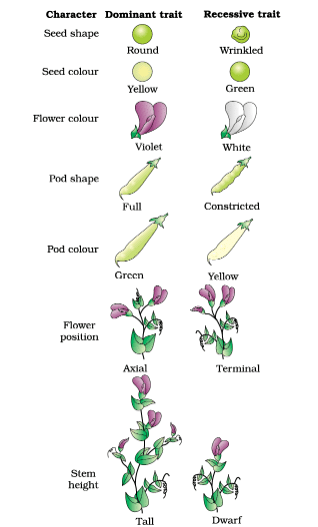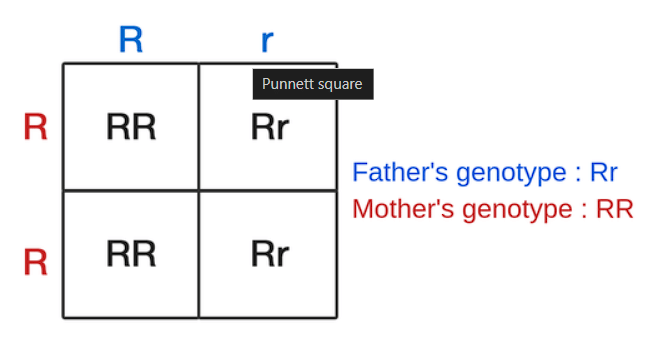Important Diagrams: Principles of Inheritance and Variation | Biology Class 12 - NEET PDF Download
Genetics is indeed the branch of biology that focuses on the inheritance of traits from parents to offspring. This field encompasses the study of genes, genetic variation, and heredity in living organisms. The principles of inheritance were first systematically studied by Gregor Mendel, often referred to as the "father of modern genetics," in the mid-19th century.
To make the understanding of genetics easy there are few diagrams that can help NEET aspirants to have deeper understanding of concepts.
1. Mendel's Law of Inheritance
- In the mid-nineteenth century, Gregor Mendel conducted hybridization experiments on garden peas (1856-1863), applying statistical analysis to study inheritance.
- He used 14 true-breeding varieties to investigate contrasting traits, such as tall vs. dwarf plants, smooth vs. wrinkled seeds, Yellow vs. green seeds and Inflated vs. constricted pod.
- His large sample size and testing across generations established fundamental rules of inheritance, which later scientists expanded upon, forming the basis of modern genetics.
 Seven pairs of contrasting traits in pea plant studied by Mendel
Seven pairs of contrasting traits in pea plant studied by Mendel
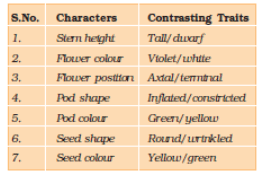 Contrasting Traits Studied by Mendel in Pea
Contrasting Traits Studied by Mendel in Pea
2. Inheritance of One Gene
Hybridization of Tall and Dwarf Peas: Mendel crossed tall (TT) and dwarf (tt) pea plants, producing F1 progeny that were all tall (Tt). The dwarf trait was not visible in the F1 generation.
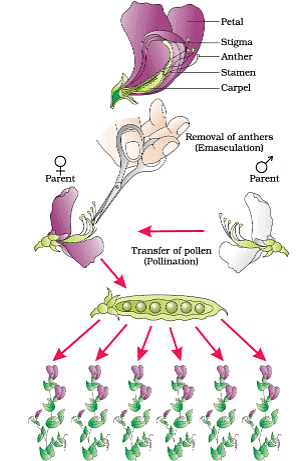 Steps in making a cross in pea
Steps in making a cross in pea
F2 Generation Results: When F1 plants (Tt) were self-pollinated, the F2 generation exhibited a 3:1 phenotypic ratio, with 3/4 tall (TT and Tt) and 1/4 dwarf (tt). This confirmed the dominance of the tall trait over dwarf.
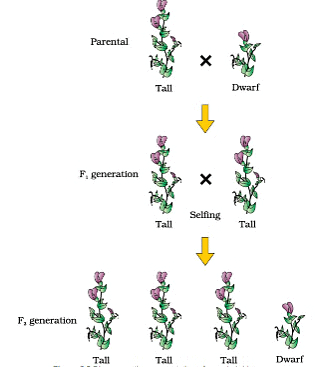 Diagrammatic representation of monohybrid cross
Diagrammatic representation of monohybrid cross
Genetic Concepts: Mendel introduced the terms "genes" and "alleles," identifying dominant (T) and recessive (t) traits. He established that homozygous genotypes (TT or tt) express consistent traits, while heterozygous genotypes (Tt) express the dominant phenotype.
Punnett Square Utilization: The Punnett Square visually represents possible genotypes from a genetic cross, showing that offspring ratios align with Mendel’s findings: 1/4 TT, 1/2 Tt, and 1/4 tt.
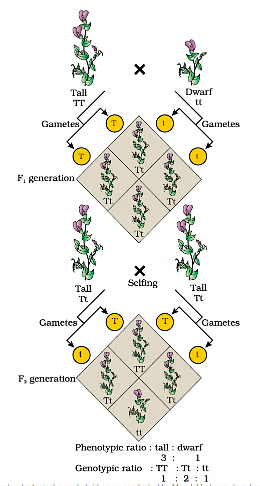 A Punnett square used to understand a typical monohybrid cross conducted by Mendel between true-breeding tall plants and true-breeding dwarf plants
A Punnett square used to understand a typical monohybrid cross conducted by Mendel between true-breeding tall plants and true-breeding dwarf plants
Test Cross for Genotype Determination: To determine the genotype of a tall F2 plant, Mendel performed a test cross by breeding it with a dwarf plant (tt). The resulting offspring's phenotypes indicate the genotype of the tall parent, helping distinguish between homozygous (TT) and heterozygous (Tt) traits.
Mendel's experiments laid the foundation for understanding inheritance patterns, demonstrating the principles of dominance, segregation, and genotype determination through test crosses.
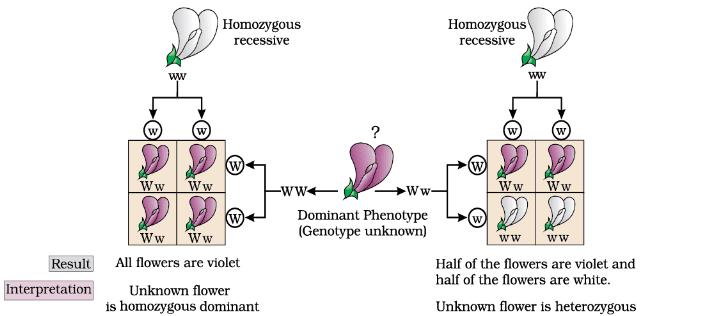 Diagrammatic representation of a test cross
Diagrammatic representation of a test cross
3. Law of Incomplete Dominance
In some plant crosses, such as with snapdragons (Antirrhinum), the F1 generation exhibits a phenotype that blends the traits of both parents. For example, crossing true-breeding red-flowered (RR) and white-flowered (rr) plants results in pink (Rr) flowers. When the F1 plants are self-pollinated, the F2 generation reveals a 1:2:1 ratio of phenotypes: 1 red (RR), 2 pink (Rr), and 1 white (rr), demonstrating incomplete dominance.
Understanding Dominance:Dominance occurs when one allele masks the expression of another. In a diploid organism, each gene has two alleles, which can be identical or different. The dominant allele typically produces a functional enzyme or trait, while the recessive allele may produce a non-functional enzyme or none at all, leading to the expression of the recessive phenotype. Thus, the phenotype depends on the presence and function of the dominant allele.
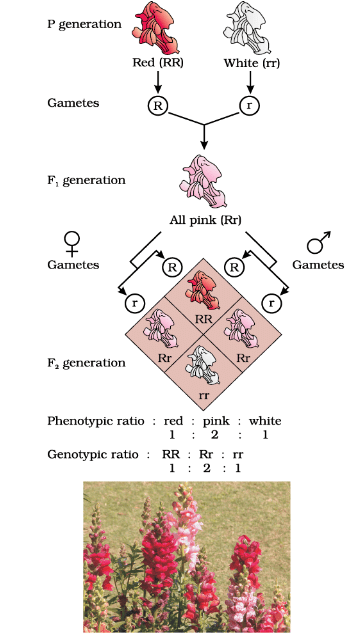 Results of monohybrid cross in the plant Snapdragon, where one allele is incompletely dominant over the other allele
Results of monohybrid cross in the plant Snapdragon, where one allele is incompletely dominant over the other allele
4. Co-Dominance
- Co-dominance occurs when the F1 generation exhibits traits from both parents, exemplified by the ABO blood group system in humans. The ABO blood groups are controlled by the I gene, which has three alleles: I, Iand i. Alleles I and I are dominant over i, but when I and I are present together, both sugar types are expressed on red blood cells, illustrating co-dominance.
- Additionally, this example showcases multiple alleles, as three alleles govern the same trait, leading to six possible genotypes and four distinct phenotypes in a population.
- In another case, starch synthesis in pea seeds involves two alleles (B and b) that produce different starch grain sizes. While BB homozygotes produce large grains and show dominance, Bb heterozygotes produce intermediate-sized grains, indicating incomplete dominance in this context.
- Overall, dominance depends not only on the alleles involved but also on the specific traits being observed, as a single gene can influence multiple phenotypes.
 Table Showing the Genetic Basis of Blood Groups in Human Population
Table Showing the Genetic Basis of Blood Groups in Human Population
5. Inheritance of Two Genes
Mendel's Dihybrid Cross and Dominance
Mendel conducted dihybrid crosses using pea plants differing in two traits: seed color (yellow vs. green) and seed shape (round vs. wrinkled). He found that the F1 generation produced seeds that were both yellow and round, indicating that yellow color (Y) is dominant over green (y), and round shape (R) is dominant over wrinkled (r).
Genotype of Parent Plants:
- Yellow round: RRYY
- Green wrinkled: rryy
Crossing Gametes:
- Gametes produced: RY (from RRYY) and ry (from rryy)
- Resulting F1 genotype: RrYy
When Mendel self-pollinated the F1 plants (RrYy), the F2 generation showed:
- Yellow seeds: 3/4
- Green seeds: 1/4
- The same 3:1 ratio was observed for seed shape, with round seeds also dominating over wrinkled seeds.
This confirmed that the traits segregated independently, consistent with Mendel’s principles of inheritance.
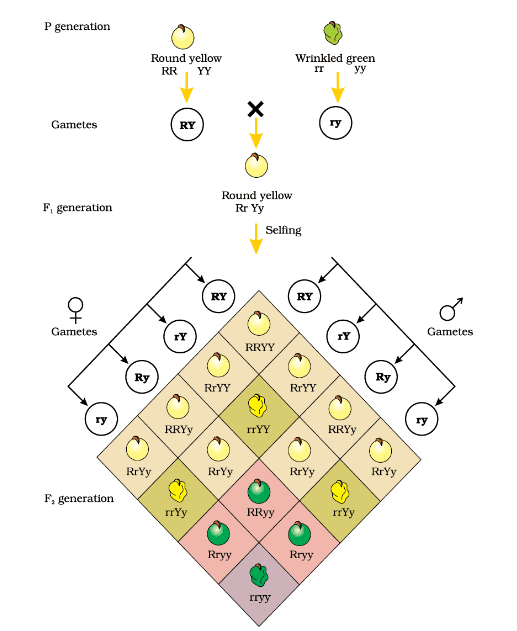 Results of a dihybrid cross where the two parents differed in two pairs of contrasting traits: seed colour and seed shape
Results of a dihybrid cross where the two parents differed in two pairs of contrasting traits: seed colour and seed shape
6. Chromosomal Theory of Inheritance
Publication and Initial Ignorance: Mendel published his findings on inheritance in 1865, but several factors contributed to its lack of recognition until 1900:
- Limited Communication: In Mendel's time, dissemination of scientific information was not as efficient, hindering widespread knowledge of his work.
- Contemporary Skepticism: His concepts of discrete genetic units (later termed genes) and non-blending alleles clashed with prevailing beliefs about continuous variation in traits.
- Mathematical Approach: Mendel's use of mathematics to explain biological concepts was unconventional and met with resistance from his contemporaries.
- Lack of Physical Evidence: Mendel could not provide physical proof of genes or their composition, which limited acceptance of his theories.
Rediscovery in 1900: In 1900, scientists Hugo de Vries, Carl Correns, and Erich von Tschermak independently rediscovered Mendel’s work, coinciding with advancements in microscopy.
Discovery of Chromosomes: As microscopy improved, scientists observed structures in the nucleus, termed chromosomes, which doubled and divided during cell division.
Linking Chromosomes to Mendelian Genetics: By 1902, researchers Walter Sutton and Theodore Boveri established parallels between chromosome behavior during meiosis and Mendel’s laws of inheritance, confirming that genes are located on chromosomes.
Key Insights:
- Both chromosomes and genes occur in pairs.
- Alleles of a gene pair are found on homologous chromosomes at corresponding sites.
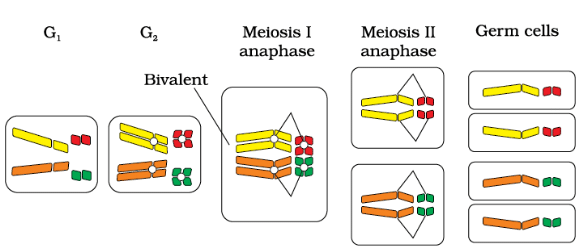 Meiosis and germ cell formation in a cell with four chromosomes.
Meiosis and germ cell formation in a cell with four chromosomes.
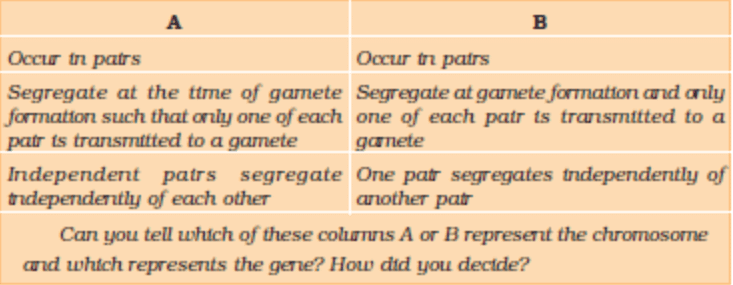 A Comparison between the Behaviour of Chromosomes and Genes
A Comparison between the Behaviour of Chromosomes and Genes
During Anaphase of meiosis I, the two chromosome pairs can align at the metaphase plate independently of each other. To understand this, compare the chromosomes of four different colour in the left and right columns. In the left column (Possibility I) orange and green is segregating together. But in the right hand column (Possibility II) the orange chromosome is segregating with the red chromosomes.
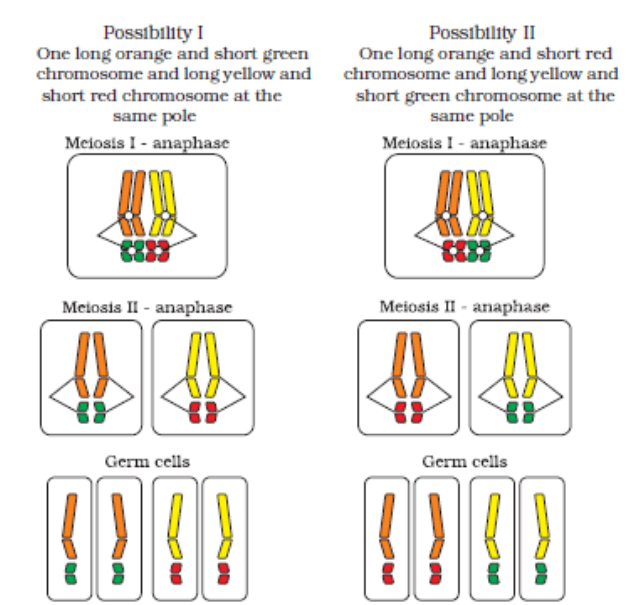 Independent assortment of chromosomes
Independent assortment of chromosomes
Sutton and Boveri proposed that the pairing and separation of chromosomes during cell division explained the segregation of genetic factors (genes). This idea led to the chromosomal theory of inheritance, which Sutton linked to Mendelian principles. Thomas Hunt Morgan further validated this theory through experiments with Drosophila melanogaster (fruit flies), chosen for their rapid life cycle, ease of breeding, and visible genetic variations. Morgan’s work established a clear connection between chromosomal behavior and the genetic variations produced by sexual reproduction.
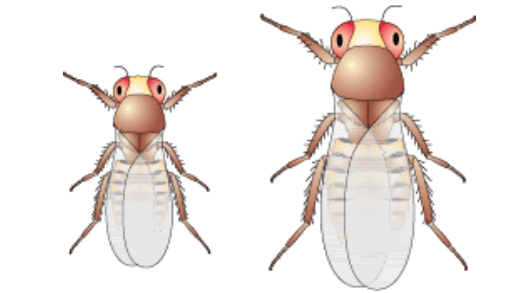 Drosophila melanogaster (a) Male (b) Female
Drosophila melanogaster (a) Male (b) Female
 |
Test: Pedigree Analysis (NCERT)
|
Start Test |
7. Linkage and Recombination
- Morgan conducted dihybrid crosses in Drosophila melanogaster to study sex-linked genes, similar to Mendel's experiments with peas. He observed that the F2 ratios deviated from the expected 9:3:3:1 ratio, indicating that the two genes did not segregate independently.
- Recognizing that these genes were located on the X chromosome, Morgan introduced the concepts of linkage (the physical association of genes on a chromosome) and recombination (the formation of non-parental gene combinations).
- He discovered varying degrees of linkage among genes: some were tightly linked with low recombination rates, while others showed higher recombination.
- Alfred Sturtevant used recombination frequencies to create genetic maps, which are now essential for sequencing entire genomes, including the Human Genome Project.
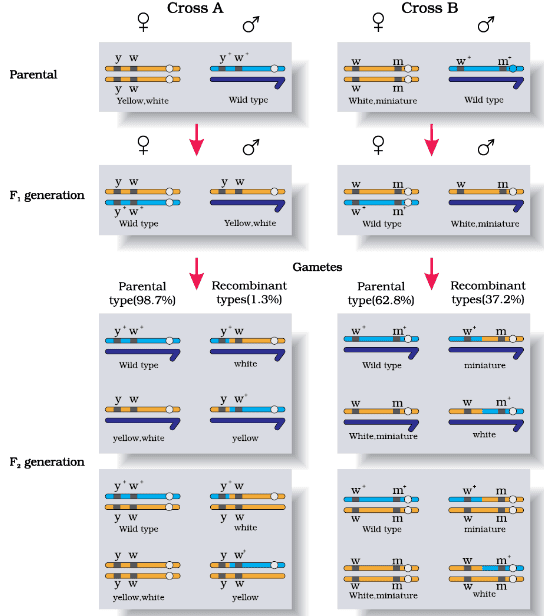 Linkage: Results of two dihybrid crosses conducted by Morgan. Cross A shows crossing between gene y and w; Cross B shows crossing between genes w and m. Here dominant wild type alleles are represented with (+) sign in superscript Note: The strength of linkage between y and w is higher than w and m.
Linkage: Results of two dihybrid crosses conducted by Morgan. Cross A shows crossing between gene y and w; Cross B shows crossing between genes w and m. Here dominant wild type alleles are represented with (+) sign in superscript Note: The strength of linkage between y and w is higher than w and m.
8. Sex Determination
- The genetic mechanism of sex determination has intrigued scientists, with early insights stemming from insect studies.
- In 1891, Henking identified a structure in sperm during spermatogenesis, later recognized as the X chromosome.
- In many insects, sex determination follows the XO model: eggs carry an X chromosome, while sperm may carry either an X or none. Fertilization by X-bearing sperm results in females, while non-X sperm produces males. For example, grasshoppers have males with one X chromosome and females with two.
- Further research revealed the XY system in mammals, including humans and Drosophila, where both sexes have equal chromosome numbers. Males possess one X and one smaller Y chromosome, while females have two X chromosomes. This results in males producing two types of gametes (X or Y), termed male heterogamety.
- Conversely, some organisms like birds exhibit female heterogamety, where females produce two types of gametes (Z or W). In this system, both sexes have the same total chromosome count, with females carrying one Z and one W chromosome, while males have two Z chromosomes.
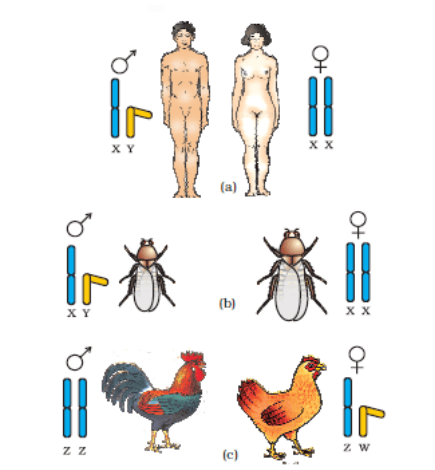 Determination of sex by chromosomal differences: (a,b) Both in humans and in Drosophila, the female has a pair of XX chromosomes (homogametic) and the male XY (heterogametic) composition; (c) In many birds, female has a pair of dissimilar chromosomes ZW and male two similar ZZ chromosomes
Determination of sex by chromosomal differences: (a,b) Both in humans and in Drosophila, the female has a pair of XX chromosomes (homogametic) and the male XY (heterogametic) composition; (c) In many birds, female has a pair of dissimilar chromosomes ZW and male two similar ZZ chromosomes
In Honey Bee
In honey bees, sex determination follows a haplodiploid system based on chromosome sets. Fertilized eggs, resulting from the union of sperm and egg, develop into females (queens or workers) and are diploid, having 32 chromosomes. In contrast, unfertilized eggs develop into males (drones) through parthenogenesis and are haploid, possessing only 16 chromosomes.
This unique system has distinct features: male bees produce sperm through mitosis, meaning they do not have fathers and cannot have sons. However, they do have grandfathers and can have grandsons.
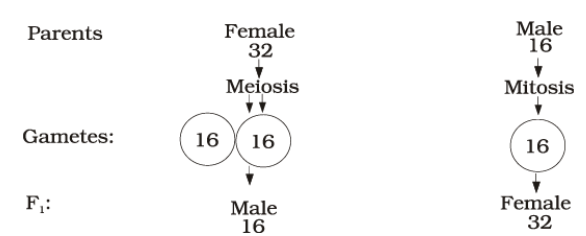 Sex determination in honey bee
Sex determination in honey bee
9. Mutation( Pedigree Analysis)
The understanding of inherited disorders has existed for a long time, largely based on observable traits within families. After Mendel's work was rediscovered, the analysis of inheritance patterns in humans began. Unlike controlled crosses in plants, human genetic studies rely on pedigree analysis, which maps the inheritance of specific traits, abnormalities, or diseases across generations.
In pedigree analysis, a family tree visually represents these traits, using standardized symbols. Each trait is controlled by genes on DNA, which is passed down generations without change. However, mutations—alterations in the genetic material—can occur and are associated with various human disorders linked to inherited changes in genes or chromosomes.
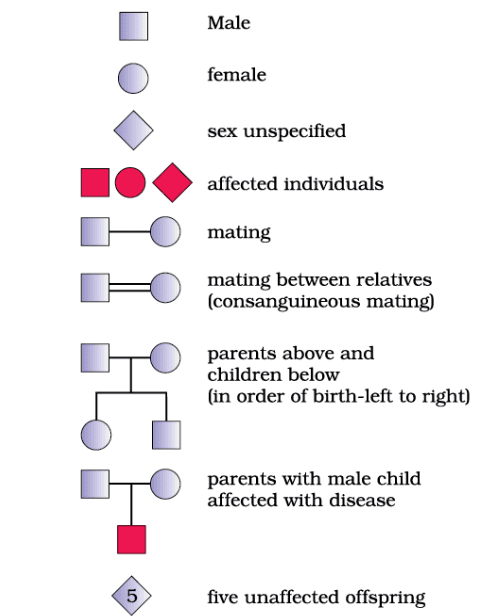 Symbols used in the human pedigree analysis
Symbols used in the human pedigree analysis
10. Mendelian Disorders
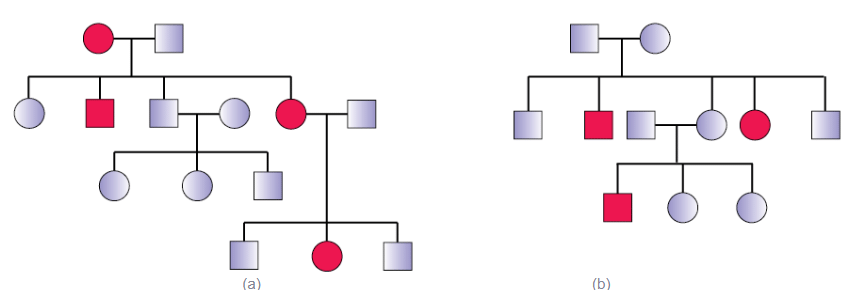 Representative pedigree analysis of (a) Autosomal dominant trait (for example: Myotonic dystrophy) (b) Autosomal recessive trait (for example: Sickle-cell anaemia)
Representative pedigree analysis of (a) Autosomal dominant trait (for example: Myotonic dystrophy) (b) Autosomal recessive trait (for example: Sickle-cell anaemia)
Sickle-cell anemia is an autosomal recessive disorder caused by a mutation in the hemoglobin gene. It is controlled by two alleles: HbA (normal) and HbS (mutant). Only individuals homozygous for HbS (HbSHbS) exhibit the disease, while heterozygous carriers (HbAHbS) appear healthy but can pass the mutant allele to their offspring, leading to a 50% chance of having affected children.
The disease results from a single amino acid substitution in the beta globin chain of hemoglobin, where glutamic acid (Glu) is replaced by valine (Val) at the sixth position due to a mutation from GAG to GUG. This change causes hemoglobin to polymerize under low oxygen levels, transforming red blood cells from their normal biconcave shape to a sickle shape, which can lead to various health complications.
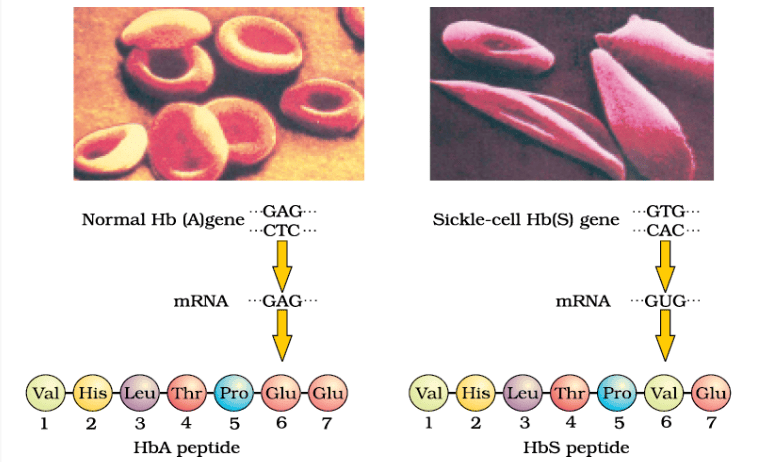 Micrograph of the red blood cells and the amino acid composition of the relevant portion of β-chain of haemoglobin: (a) From a normal individual; (b) From an individual with sickle-cell anaemia
Micrograph of the red blood cells and the amino acid composition of the relevant portion of β-chain of haemoglobin: (a) From a normal individual; (b) From an individual with sickle-cell anaemia
 |
Download the notes
Important Diagrams: Principles of Inheritance and Variation
|
Download as PDF |
11. Chromosomal Disorders
Down’s Syndrome : The cause of this genetic disorder is the presence of an additional copy of the chromosome number 21 (trisomy of 21). This disorder was first described by Langdon Down (1866). The affected individual is short statured with small round head, furrowed tongue and partially open mouth . Palm is broad with characteristic palm crease. Physical, psychomotor and mental development is retarded.
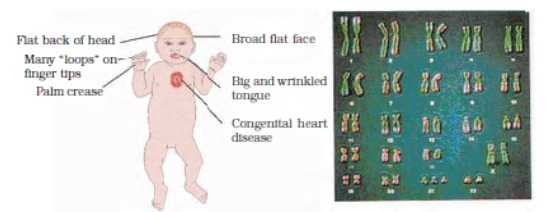 A representative figure showing an individual inflicted with Down’s syndrome and the corresponding chromosomes of the individual
A representative figure showing an individual inflicted with Down’s syndrome and the corresponding chromosomes of the individual
Klinefelter’s Syndrome : This genetic disorder is also caused due to the presence of an additional copy of Xchromosome resulting into a karyotype of 47, XXY. Such an individual has overall masculine development, however, the feminine development (development of breast, i.e., Gynaecomastia) is also expressed . Such individuals are sterile.
Turner’s Syndrome : Such a disorder is caused due to the absence of one of the X chromosomes, i.e., 45 with X0, Such females are sterile as ovaries are rudimentary besides other features including lack of other secondary sexual characters
 Diagrammatic representation of genetic disorders due to sex chromosome composition in humans : (a) Klinefelter Syndrome; (b) Turner’s Syndrome
Diagrammatic representation of genetic disorders due to sex chromosome composition in humans : (a) Klinefelter Syndrome; (b) Turner’s Syndrome
Diagram Based Questions - NEET
Q1:A pink flowered Snapdragon plant was crossed with a red flowered Snapdragon plant. What type of phenotype/s is/are expected in the progeny? (NEET 2024)
(a) Only red flowered plants
(b) Red flowered as well as pink flowered plants
(c) Only pink flowered plants
(d) Red, Pink as well as white flowered plants
Ans: (b)
Pink colour flower in snapdragon have genotype Rr
Red flowered snapdragon have genotype RR when they both are crossed So the progeny that we get are red and pink flowered plants only.
So the progeny that we get are red and pink flowered plants only.
Q2: As per ABO blood grouping system, the blood group of father is B+ , mother is A+ and child is O+ . Their respective genotype can be
A. IBi / IAi / ii
B. IBIB/ IAIA/ ii
C. IAIB/ iIA/ IBi
D. IAi/IBi/IAi
E. iIB / iIA / IAIB
Choose the most appropriate answer from the options given below : (NEET 2024)
(a) A only
(b) B only
(c) C & B only
(d) D & E only
Ans: (a)
The ABO blood group is determined by alleles IA, IB, and i, which are responsible for producing A, B, and O blood types, respectively. The IA and IB alleles are codominant, meaning both can be expressed if both are present, whereas the i allele is recessive.
Given the blood types in the problem statement:
 To find the correct pairing:
To find the correct pairing:
The child has an O blood type, meaning their genotype must be ii, indicating they inherited an i allele from each parent. Therefore, both parents must have at least one i allele.
Given this information:
Father's Genotype: It must include i since the child inherited i. Thus, the father's genotype could be IBi.
Mother's Genotype: It must also include i for the same reason, so the mother's genotype could be IAi.
Child's Genotype: It is confirmed as ii.
Matching this analysis with the provided options:
Option A: IBi/IAi/ii - This matches the reasoning provided.
Option B: IBIB/IAIA/ii - This is incorrect because it suggests that neither parent has a recessive i allele to pass to the child, which is necessary for the child’s blood type O.
Option C: iIB/iIA/IAIB - This is incorrect and does not match the required genotypes for the child to inherit ii.
Option D: IAi/IBi/IAi - This includes a typo in the children's genotype and misalignment with blood types.
Option E: iIB/iIA/IAIB - This is incorrect, mismatches the inheritance mechanism.
So the correct pairing based on the genotypes and blood groups mentioned, along with genetic laws, would be Option "A",
So the answer is: Option A
Q3: Which one of the following symbols represents mating between relatives in human pedigree analysis? (NEET 2023)
(a) 
(b) 
(c) 
(d) 
Ans: (b)
The symbol representing mating between relatives (consanguineous mating) in human pedigree analysis is 
Q4: The production of gametes by the parents the formation of zygotes, the F1 and F2 plants can be understood using (NEET 2021)
(a) Pie diagram
(b) A pyramid diagram
(c) Punnett square
(d) Wenn diagram
Ans. c
The production of gametes by the parents, the formation of the zygotes, the F1 and F2 plants can be understood from a diagram called Punnett Square as shown in Figure given below
Q5. In Antirrhinum (Snapdragon), a red flower was crossed with a white flower and in F1 generation all pink flowers were obtained. When pink flowers were soiled, the F2 generation showed white, red and pink flowers. Choose the incorrect statements from the following. (NEET 2019)
(a) Law of segregation does not apply in this experiment.
(b) This experiment docs not follow the Principle of Dominance.
(c) Pink colour in is due to incomplete dominance.
(d) Ratio of F2 is
Ans. a
Law of segregation applies in this case as when pink (lowers obtained in F1, are selfed then red and while (lowers are obtained in F2 which indicates that there is no mixing of gametes.
|
78 videos|280 docs|174 tests
|
FAQs on Important Diagrams: Principles of Inheritance and Variation - Biology Class 12 - NEET
| 1. What are Mendel's Laws of Inheritance and how do they apply to genetic traits? |  |
| 2. What is the difference between incomplete dominance and co-dominance in inheritance? |  |
| 3. How does the chromosomal theory of inheritance explain genetic variation? |  |
| 4. What is the significance of mutations in genetics? |  |
| 5. What are Mendelian disorders and how are they inherited? |  |


